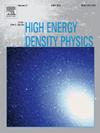研究国家点火装置内爆三维不对称的多火箭活塞模型
IF 0.9
3区 物理与天体物理
Q3 PHYSICS, FLUIDS & PLASMAS
引用次数: 0
摘要
在国家点火装置(NIF)中,惯性约束聚变(ICF)内爆实现了点火和增益大于1。这些成就需要产生高热点压力的内爆,这些热点压力最初被致密的DT燃料壳所限制。然而,即使在燃烧和点燃等离子体状态下,三维不对称也会减少壳动能与热点的耦合,从而损害整体内爆性能并截断燃烧。同样,通过保持从内爆壳到热点的高效能量耦合,可以最小化内爆的总体规模。最近的实验通常显示出显著的三维不对称迹象,表现为高热点速度或自发射和散射中子图像的不对称。在模拟三维内爆不对称时,通常采用全尺寸流体力学模拟,这是一种劳动密集型和计算成本高的方法。因此,3D模拟只适用于特殊情况,如特别感兴趣的实验。为了能够更广泛地研究三维射击后分析,采用了一种近似但计算成本低廉的方法,即使用多个火箭活塞离散球形内爆。这些火箭活塞通过中心热点压力通过功率平衡方程耦合在一起。该方法类似于施普林格[施普林格等人,核聚变59(3)(2019)]报道的方法,包括从火箭内爆阶段开始的近似全息模型,以及对停滞和峰值燃烧时的真实合成诊断数据的后处理。该火箭活塞工具可以提供近似的3D图像和诊断数据,然后可以与数据进行定量比较,从而实现迭代、正演拟合和机器学习等新技术来解释测量结果。本文章由计算机程序翻译,如有差异,请以英文原文为准。
A multi-rocket piston model to study three-dimensional asymmetries in implosions at the national ignition facility
Ignition and gain greater than unity has been achieved in inertial confinement fusion (ICF) implosions at the National Ignition Facility (NIF). These accomplishments required implosions that produced high hotspot pressures that are inertially confined by a dense shell of DT fuel. However, even in the burning and igniting plasma regime, 3D asymmetries can reduce the coupling of shell kinetic energy to the hotspot harming the overall implosion performance and truncating burn. Likewise, the overall scale of the implosion can be minimized by maintaining a high efficiency of energy coupling from the imploding shell to the hotspot. Recent experiments commonly show signs of significant 3D asymmetry that manifest as high hotspot velocity or asymmetry in the self-emission and scattered neutron images. While modeling 3D asymmetries in implosion with full scale hydrodynamic simulations is often performed, it is labor intensive and computationally costly. Therefore, 3D simulation is applied only in special cases like experiments of particular interest. To enable a wider survey of 3D post-shot analysis, an approximate but computationally inexpensive approach is applied by using multiple rocket-pistons discretizing the spherical implosion. These rocket-pistons are coupled together through the central hotspot pressure using the power balance equations. The approach is similar to that reported by Springer [Springer et al., Nuclear Fusion 59 (3) (2019)] with the inclusion of an approximate hohlraum model beginning at the rocket-implosion stage and post-processing of realistic synthetic diagnostic data at the stagnation and peak burn. This rocket piston tool can provide approximate 3D image and diagnostic data that can then be compared quantitively with data enabling new techniques in iterative, forward fitting, and machine learning to interpreting measurements.
求助全文
通过发布文献求助,成功后即可免费获取论文全文。
去求助
来源期刊

High Energy Density Physics
PHYSICS, FLUIDS & PLASMAS-
CiteScore
4.20
自引率
6.20%
发文量
13
审稿时长
6-12 weeks
期刊介绍:
High Energy Density Physics is an international journal covering original experimental and related theoretical work studying the physics of matter and radiation under extreme conditions. ''High energy density'' is understood to be an energy density exceeding about 1011 J/m3. The editors and the publisher are committed to provide this fast-growing community with a dedicated high quality channel to distribute their original findings.
Papers suitable for publication in this journal cover topics in both the warm and hot dense matter regimes, such as laboratory studies relevant to non-LTE kinetics at extreme conditions, planetary interiors, astrophysical phenomena, inertial fusion and includes studies of, for example, material properties and both stable and unstable hydrodynamics. Developments in associated theoretical areas, for example the modelling of strongly coupled, partially degenerate and relativistic plasmas, are also covered.
 求助内容:
求助内容: 应助结果提醒方式:
应助结果提醒方式:


